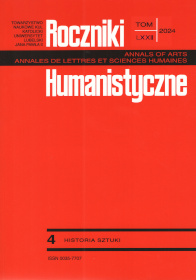Między traditio i renovatio Ecclesiae. O średniowiecznych krucyfiksach triumfalnych i ich nowych aranżacjach w Rzeczypospolitej XVI-XVIII wieku
Between Traditio and Renovatio Ecclesiae: On Medieval Roods in the Polish-Lithuanian Commonwealth and Their New Settings in the 16th-18th Centuries
Author(s): Dobrosława Horzela, Marek WalczakSubject(s): Fine Arts / Performing Arts, History of Art
Published by: Towarzystwo Naukowe KUL & Katolicki Uniwersytet Lubelski Jana Pawła II
Keywords: renovatio Ecclesie; counter refomration; Council of Trent; Gothic sculpture; furnishings of church interiors; Polish-Lithuanian Commonwealth
Summary/Abstract: An important role in the Catholic image theory and its approach towards religious practices in the post-Tridentine period was played by the notion of antiquity. In keeping with this principle, material remnants of the past became important arguments attesting to the veracity of the doctrine and custom of the Roman Church. In the Polish-Lithuanian Commonwealth liturgical reforms initiated at the Council of Trent started to be implemented relatively promptly. Considering the quickly advancing radical alterations made to the furnishings of church interiors, it is worthy of note that very often old roods located in medio ecclesiae would have been left untouched. According to rough estimations, around two hundred Gothic roods have survived in Lesser Poland, including almost thirty groups consisting of the figures of St John the Evangelist and the Virgin Mary and almost fifty attendant figures originally associated with the no longer surviving roods. Among the most important criteria for deciding about what measures should be applied in the renovation of churches was the visibility of the high altar. The use of precious metals was a common method of emphasising the highest rank of venerated images, that was recommended by church writers. In contrast, the ex-votis in the form of portraits, hung in the vicinity of the roods, usually in medio ecclesiae, seem to be a uniquely Polish phenomenon. These were known as coffin portraits, that is paintings on metal panels, often silver, unknown in other parts of the continent, that were attached to the front wall of a coffin or displayed before it during the funeral ceremonies of members of the nobility and aristocracy. Another artistic device, characteristic of the Polish-Lithuanian Commonwealth, was the construction of architectural and sculptural structures within chancel arches which, while emphasising the boundary between choir and nave, formed a visual frame of the high altar. In numerous rural churches, especially in the poor areas at the feet of the Tatra Mountains, which were mostly built of timber, medieval roods accompanied by sculpted or painted decoration have survived to this day, in other places the worship-related circumstances resulted in the removal of the figures from the centre of the church to one of the altars. The preservation and veneration of medieval triumphal crucifixes in the early modern period seems to have been a particularly important manifestation of attempts at keeping a balance between the traditio and renovatio Ecclesiae.
Journal: Roczniki Humanistyczne
- Issue Year: 72/2024
- Issue No: 4
- Page Range: 57-98
- Page Count: 42
- Language: Polish

